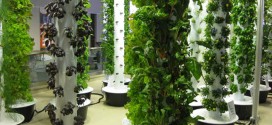Aeroponics is the process of growing plants in an air or mist environment without the use of soil or an aggregate medium (known as geoponics). The word “aeroponic” is derived from the Greek meanings of aero- (air) and ponos (labour). Aeroponic culture differs from both conventional hydroponics and in-vitro (plant tissue culture) growing. Unlike hydroponics, which uses water as a growing medium and essential minerals to sustain plant growth, aeroponics is conducted without a growing medium. Because water is used in aeroponics to transmit nutrients, it is sometimes considered a type of hydroponics. Methods The basic principle of aeroponic growing is to grow plants suspended in a closed or semi-closed environment by spraying the plant’s dangling roots and lower stem with an atomized or sprayed, nutrient-rich water solution. The leaves and crown, often called the “canopy”, extend above. The roots of the plant are separated by the plant support structure. Many times closed cell foam is compressed around the lower stem and inserted into an opening in the aeroponic chamber, which decreases labor and expense; for larger plants, trellising is used to suspend the weight of vegetation and fruit. Ideally, the environment is kept free from pests and disease so that the plants may grow healthier and more quickly than plants grown in a medium. However, since most aeroponic environments are not perfectly closed off to the outside, pests and disease may still cause a threat. Controlled environments advance plant development, health, growth, flowering and fruiting for any given plant species and cultivars. Due to the sensitivity of root systems, aeroponics is often combined with conventional hydroponics, which is used as an emergency “crop saver” – backup nutrition and water supply – if the aeroponic apparatus fails. High-pressure aeroponics is defined as delivering nutrients to the roots via 20–50 micrometre …
Read More » Karshika Keralam – A site for Agricultural Enthusiasts
Karshika Keralam – A site for Agricultural Enthusiasts
